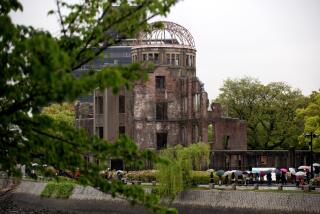George Marquardt, 84; Pilot of Plane Flying With Enola Gay on Mission to Bomb Hiroshima
- Share via
George Marquardt’s memory of the atomic blast over Hiroshima on Aug. 6, 1945, never dimmed.
“It was like the sun had come out of the ground and just exploded,” he often recalled.
For the record:
12:00 a.m. Aug. 30, 2003 For The Record
Los Angeles Times Saturday August 30, 2003 Home Edition Main News Part A Page 2 National Desk 2 inches; 95 words Type of Material: Correction
A-bomb filming -- An obituary of George Marquardt, the B-29 pilot whose plane carried photographic equipment to record the atomic blast over Hiroshima, which appeared in the California section Aug. 23, stated that Manhattan Project scientist Bernard Waldman forgot to open the shutter on the high-speed camera and that none of the film of the blast was exposed. That is incorrect, according to Harold M. Agnew, a scientist on another plane that measured the bomb’s yield. He said that Waldman operated the camera properly, but that the data on the film was lost in processing.
Marquardt, the former Army Air Forces pilot whose B-29 was designated to photograph the historic bomb blast over the Japanese port city, died in a nursing home in Murray, Utah, on Aug. 15, a day after the 58th anniversary of the Japanese surrender that ended World War II. He was 84 and had Parkinson’s disease.
As he flew toward Hiroshima from the island of Tinian, north of Guam, in the early morning of that Aug. 6, Marquardt’s B-29 -- Necessary Evil -- was to the left and rear of Col. Paul Tibbets’ Enola Gay, the B-29 carrying the atomic bomb dubbed “Little Boy.”
On the right and to the rear of the Enola Gay was Maj. Charles Sweeney’s bomber, which carried blast-gauge instruments that would be dropped by parachute.
“You boys are making history today,” a Manhattan Project scientist on Marquardt’s plane had said that morning -- a morning that, as they neared Hiroshima, Marquardt would remember as being “the most beautiful day I’ve ever seen.”
That changed soon after 8:15 a.m., when the Enola Gay’s bombardier released “Little Boy.”
Although Marquardt’s B-29 remained at least 15 miles from Hiroshima, Marquardt later said the blast “felt as if a monster hand had slapped the side of the plane.”
The light from the 9,700-pound uranium bomb with the destructive force of 20,000 tons of TNT was so intense that Marquardt could not even see his co-pilot, Jim Anderson.
Bernard Waldman, the Manhattan Project scientist on Marquardt’s plane, was equipped with a special high-speed movie camera loaded with six seconds of film to record the blast. But in his excitement, Waldman forgot to open the camera shutter, and none of the film was exposed.
In defiance of orders, however, a crew member had sneaked a camera on board and took a picture of the explosion.
The bomb, which destroyed about five square miles of Hiroshima, killed 70,000 to 100,000 people.
“I have never for one moment regretted my participating in the dropping of the A-bomb,” Marquardt told the Salt Lake Tribune in 1995. “It ended a terrible war.”
Three days after the attack on Hiroshima, a B-29 piloted by Sweeney dropped an atomic bomb on Nagasaki, which prompted the Japanese surrender.
Tibbets, a retired brigadier general, told The Times this week that if a third bomb had been necessary, he would probably have chosen Marquardt to drop it.
“He was very good,” said Tibbets, commanding officer of the top-secret 509th Composite Group, which had trained at a remote airfield in Utah. “I watched George closely, and I can say he was most trustworthy, and he was good at his business: He ran a good crew and flew a good airplane.”
Marquardt’s enlisted men, Tibbets added, “liked him and wanted to fly with him. They knew how much he appreciated them. That made them a gung-ho crew.”
Ted “Dutch” Van Kirk, the Enola Gay’s navigator, echoed Tibbets’ sentiments.
“We had 15 aircraft commanders, and George was certainly one of the better ones” in the 509th, Van Kirk said. “He was a sound individual, had good judgment and could handle the airplane and crew real well.”
Born July 14, 1919, in Princeton, Ky., Marquardt grew up in the small Ohio River town of Golconda, Ill. He was studying at Illinois Wesleyan University in Bloomington in March 1941 when he enlisted in the Army Air Forces.
He received his wings at Kelly Field in Texas and in 1943 was assigned to the 393rd Bombardment Squadron, which became part of the 509th Composite Group at Wendover Field in Utah.
Fifteen crews were being trained there to drop a large, unnamed bomb for the top-secret mission that they knew only would “shorten the war.”
On June 6, 1945, Marquardt said goodbye to Bernece, his wife of one week, in their hotel room near the airfield. Then he took off for Tinian.
“He couldn’t tell me where he was going,” his widow said this week. “In fact, he was leery about getting married, because he didn’t think he was coming back.
“I didn’t know until I read about it in the paper when the bomb was dropped. I said to my mother, ‘Now I know what George is doing and where he is.’ ”
Marquardt, who spent 45 years after the war as sales manager and vice president of Allen Steel Co. in Salt Lake City, is survived by his wife; sons Steven, Michael and Chris; daughter Michelle Judy; 11 grandchildren; and 10 great-grandchildren.
In lieu of flowers, the family requests that contributions be made in Marquardt’s name to the World War II Memorial Fund, 2300 Clarendon Blvd., Suite 501, Arlington, Va., as a tribute to “The Greatest Generation.”
More to Read
Sign up for Essential California
The most important California stories and recommendations in your inbox every morning.
You may occasionally receive promotional content from the Los Angeles Times.













